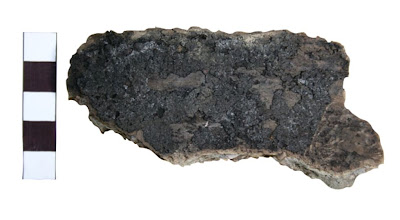 |
| Exterior shard deposit found at Neustadt [Credit: © University of York] |
The silicate remains of garlic mustard (Alliaria petiolata) along with animal and fish residues were discovered through micro-fossil analysis of carbonized food deposits from pots found at sites in Denmark and Germany. The pottery dated from the Mesolithic-Neolithic transition from hunter-gathering to agriculture.
Previously scientists have analyzed starches which survive well in carbonized and non-carbonized residues to test for the use of spices in prehistoric cooking. But the new research, which is reported in PLOS ONE, suggests that the recovery of phytoliths -- silicate deposits from plants -- offers the additional possibility to identify leafy or woody seed material used as spices, not detectable using starch analysis. Phytoliths charred by cooking are more resilient to destruction.
Lead researcher Dr Hayley Saul, of the BioArCH research center at at the University of York, said: "The traditional view is that early Neolithic and pre-Neolithic uses of plants, and the reasons for their cultivation, were primarily driven by energy requirements rather than flavor. As garlic mustard has a strong flavor but little nutritional value, and the phytoliths are found in pots with terrestrial and marine animal residues, our findings are the first direct evidence for the spicing of food in European prehistoric cuisine.
"Our evidence suggests a much greater antiquity to the spicing of foods in this region than is evident from the macro-fossil record, and challenges the view that plants were exploited by hunter-gatherers and early agriculturalists solely for energy requirements, rather than taste."


No comments:
Post a Comment